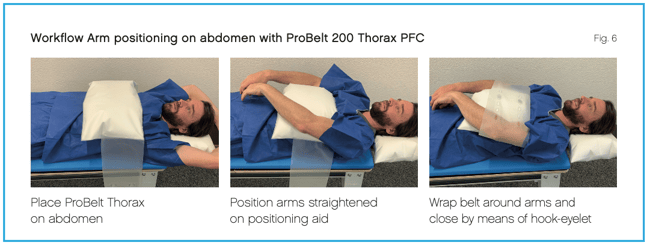Thorax/abdomen examinations are routine CT examinations in which the patient’s arms are usually positioned above the head. However, if the patient’s arms cannot be positioned above the head, correct and stable positioning are all the more important in order to avoid “photon degeneration artifacts” and not to increase the radiation exposure unnecessarily. With simple tricks and the right tools, the correct position can be reliably achieved in various situations.
In addition to the correct positioning of the arms, when standardizing workflows for these positioning situations, consideration should be given to ensuring that positioning can be performed easily, quickly and without complications, even in stressful situations. In addition, it is imperative to use hygienically safe positioning aids.
In the following, some tips are given on adequate arm positioning for thorax/abdomen examinations of motion-impaired patients.
Arms over head
It has become standard practice to have patients hold their arms above their heads during thorax/abdomen examinations. The advantage of this option is that radiation exposure and the risk of suboptimal arm position and associated artifacts can be minimized. The disadvantage of this option is that this position is not possible for all patients and may cause pain.
important key points for patient positioning arms over head:
- Place patient on table in supine position with thorax / abdomen as flat as possible
- Place head and shoulders in as comfortable a position as possible on the positioning aid and raise arms above head.
- Place forearms on the highest part of the positioning aid
- If necessary, put positioning aid underneath the legs to relieve pressure on the lumbar spine
Arms on Abdomen
The reasons why the arms are not positioned above the head can be multifaceted. In these cases, it has proven useful to position both arms on the abdomen. It is important that the arms are positioned as straight as possible with a certain distance between them on the abdomen, as this is the only way to ensure that the upper arms are high enough and artifacts can be prevented. In addition, stretching the arms ensures that the contrast medium injection can be performed without complications.
Patients with a high level of compliance usually find it easy to assume and maintain this position. However, experience has shown that patients who cannot place their arms above their head often have poor compliance or are even unconscious. Accordingly, the arms must be positioned and stabilized in this position with various positioning aids.
Important key points for patient positioning with arms on the abdomen
- Place patient on table in supine position with thorax/ abdomen as flat as possible and positiong head comfortably
- If necessary, put positioning aid underneath the legs to relieve pressure on the lumbar spine
- Arms are held in a stretched position by means of a combined solution of distance holder and belt ("Beautiful Images Cushion", ProBelt Thorax PFC, see illustration below)

This option has the advantage that, due to the integrated solution of distance holder and fixation, no extra steps are necessary and handling is therefore simple and quick. In addition, the arms are held in the correct position, which enables good image quality without artifacts (“Beautiful images cushion”). The only disadvantage is that the patients are not fixed to the table, although this is rarely necessary in the cases mentioned above.
Follow this link to download further information, such as an application video of the ProBelt Thorax and a field report by Alex Riemer. The field report illustrates the application of the "Beautiful images cushion" sharing two case studies.
Conclusion
Thorax / abdomen examinations are part of the most common CT examinations. The correct positioning of the arms is very important to avoid artifacts and unnecessary radiation exposure. In both the arms-over-head and arms- on-the-abdomen methods, patient positioning can be simplified and improved with simple measures and appropriate positioning tools. Especially in the case of ICU or polytrauma patients, the right tools can also be a great help in securing cables and tubes.
_ _ _ _ _ _ _ _ _ _ _ _ _ _ _ _ _ _ _ _ _ _ _ _ _ _ _ _ _ _ _ _ _ _ _ _ _ _ _ _ _ _ _ _ _ _ _ _ _ _ _ _
About PEARL TECHNOLOGY
Pearl Technology AG, based in Schlieren, offers innovative solutions for the placement, positioning and immobilization of patients in radiology and radiotherapy. The products are manufactured in Switzerland according to ISO norm 13485 and are characterized by simple handling, high patient comfort and excellent hygiene which guarantees smooth and safe examination processes.
Download further information on our patient positioning portfolio for radiology and nuclear medicine or contact us directly in order to receive further information on our patient positioning solutions.

